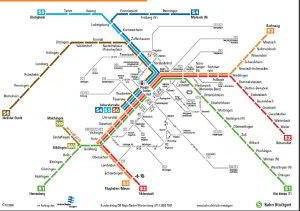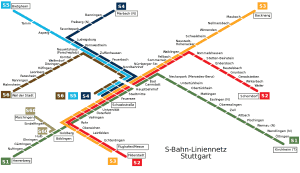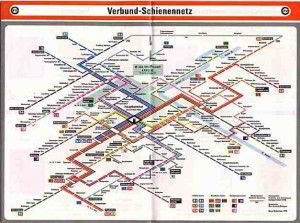The Stuttgart Urban Train, also known as “Stuttgarter Stadtbahn”, plays a key role in this city's public transportation network, which is located in Germany. With a network that includes 14 lines and 19 stations, covers a distance of 24 kilometres (about 14.91 miles). The system was inaugurated on 10 June 1966 and has been expanded several times, the most recent in 2021, continually improving its capacity and service.
Below we show you several versions of the Stuttgart metro map.
Stuttgart Subway Timetable
- Weekdays and Saturdays: of 5:00 until 0:00 hours.
- Sundays and holidays: of 6:00 until 0:00 hours.
Rates
- Price of a single ticket in local currency: 2.90 EUR
- Price of a single ticket in dollars: 3.18 USD
Official Web site
History of the Stuttgart Metro
The history of the Stuttgart metro dates back to the 19th century with the creation of the Stuttgarter Pferde-Eisenbahn-Gesellschaft in 1868, which introduced the first horse-drawn tram services. This company, after several mergers and expansions, became what we know today as Stuttgarter Straßenbahnen AG (SSB). During the first years, The system consisted mainly of trams that were electrified in the early 20th century..
Transition from tram to metro The most significant transformation occurred in 1985, when the Stadtbahn was officially opened. This change represented a profound modernization, moving from a tram system to a light metro with more advanced technical specifications and greater capacity. This process included the adaptation of part of the existing infrastructure and the construction of new sections, many of them underground, to adapt them to the new transportation system.
Expansion and modernization Since its inauguration, the Stadtbahn has continued to expand. In the decade of 2000, New lines were inaugurated and significant improvements were made to existing infrastructure. More recently, Projects have been carried out to extend several lines to new suburban areas and improve connectivity between different sectors of the city. These projects reflect the adaptation of the system to the growing needs of an expanding metropolis.
Recent innovations The Stadtbahn network has not only grown in terms of geographical coverage but also in technology and services. For example, the implementation of additional services during special events and the introduction of more modern and energy efficient vehicles, are part of these innovations
History of the subway map
- 1985: With the inauguration of the Stadtbahn system, the first official maps representing the operational lines at that time were adopted. These maps were focused on showing a clear transition from the old tram system.
- Subsequent Changes: As new lines were added and the network expanded over the years 90 y 2000, maps have been updated to reflect these extensions. For example, the extension to the airport and the new Messe (trade fair) involved significant updates to the system representation.
- Recent Modifications: With the expansion of 2016-2018, where more stations and lines were included, A complete design review was performed to improve understandability and visual accessibility.
Interventions and design
- Although specific records about individual designers are not widely available, It is common for these projects to be carried out internally by SSB planning teams or through collaborations with graphic design firms specialized in signage and mapping..
Technology adoption and accessibility
- In the last decade, emphasis has been placed on the digital compatibility of the map, ensuring that users can access through applications and online platforms. This includes integration with real-time information systems.
Additional data
The Stuttgart metro not only facilitates urban mobility but is also integrated into the cultural and tourist development of the city. The Stadtbahn network is constantly expanding with recent projects including the extension of line U13 and significant infrastructure improvements such as the construction of a new depot in Weilimdorf.
Stuttgart is noted for its cultural life and a series of events that attract locals and tourists alike.. From music festivals to cultural events, The city offers a rich diversity of activities. Important events such as the Stuttgarter Frühlingsfest and the Cannstatter Volksfest are just some of the attractions that enrich life in this metropolis..








